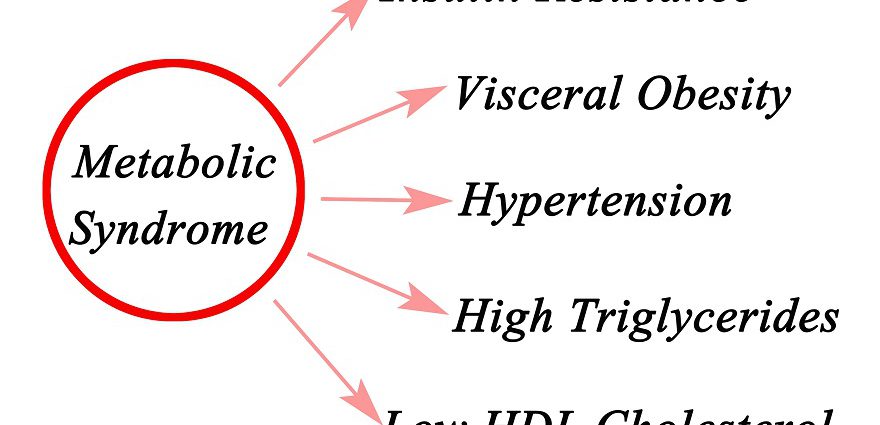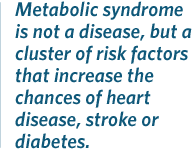Metabolic Syndrome

Here you’ll find information on:
Metabolic syndrome goes by many names, but whether you call it Syndrome X, dysmetabolic syndrome or insulin resistance syndrome, being aware of how this condition can wreak havoc on your body may save your life.
A person with metabolic syndrome has approximately twice the risk for coronary heart disease and five times the risk for type 2 diabetes, but simple lifestyle changes along with medication and other interventions, when necessary, can dramatically improve your health and well-being.
What Is Metabolic Syndrome?
Metabolic syndrome is not a disease, per se. It is actually a cluster of risk factors that increase the chances of heart disease, stroke or diabetes. According to the American Heart Association and the National Heart, Lung, and Blood Institute, these risk factors include:
A large amount of abdominal or belly fat. This means you if you are a man and your waist measures more than 40 inches or if you are a woman and your waist measures more than 35 inches.

Low levels of high density lipoprotein (HDL) or “good” cholesterol. This means you if you are male and your HDL is less than 40 milligrams per deciliter (mg/dL) of blood, if you are female and your HDL is less than 50 mg/dl or you are currently on medicine to raise your HDL. (Read more about cholesterol.)
High levels of dangerous blood fats known as triglycerides. This means you if your triglycerides are 150 mg/dl or higher, or you are currently on medication to lower them.
High blood pressure or hypertension. This means you if your blood pressure is 135/85 millimeters of mercury (mmHg) or higher, or you are currently on medication to reduce your blood pressure. The top number is your systolic pressure or the pressure created when your heart beats. The bottom number is your diastolic pressure or the pressure inside blood vessels when the heart is at rest.
High blood glucose (blood sugar). This means you if your fasting glucose is 100 mg/dl or higher, or you are currently on medication to lower your glucose levels.
If you have three or more of the above risk factors, you have metabolic syndrome.
(Keep in mind that not all medical professionals agree on what risk factors constitute metabolic syndrome, or if it really exists as a defined medical problem.)
If you have metabolic syndrome, you are certainly not alone. About 47 million adults in the United States have metabolic syndrome, and the numbers continue to grow, according to the American Heart Association.
What Causes Metabolic Syndrome?
No one can say for certain what causes metabolic syndrome, but at the heart of it is a condition known as insulin resistance.
If you have metabolic syndrome, your body is resistant to the hormone insulin, which is produced by the pancreas. It helps the body use glucose, or blood sugar. Your cells need glucose for energy. If you are resistant to the effects of insulin, the pancreas overcompensates and secretes additional insulin. The cells may resist the high levels of insulin, and glucose, in turn, builds up in the blood, resulting in high blood glucose or type 2 diabetes.
Being overweight, a lack of physical activity and eating a poor diet certainly play a role in causing insulin resistance and metabolic syndrome.
Metabolic Syndrome Treatment
The good news is that metabolic syndrome can be controlled by making positive lifestyle changes, including eating a healthy, low-calorie diet, exercising regularly and possibly taking medications to control your blood sugar, cholesterol, triglycerides or blood pressure.
Currently doctors recommend:
- Weight loss to achieve a body mass index (BMI) of less than 25. A BMI takes height and weight into account to measure body fatness. A BMI of 25-29.9 is considered overweight, and a BMI of 30 or greater is considered obese.
- Increased physical activity. Strive for least 30 minutes of moderate-intensity activity on most days of the week.
- Healthy eating habits. This includes less artery-clogging saturated fat, trans fat and cholesterol.
- Quitting smoking. Although smoking is not a risk factor for metabolic syndrome, it greatly increases the risk of heart disease and stroke.
- Medication. In some cases, medication may be needed to lower blood pressure, triglyecerides or glucose levels and or boost levels of HDL cholesterol. Medications don’t cure these conditions, but they do reduce the amount of destruction that they have on the body.
- Bariatric surgery. For some severely obese individuals with metabolic syndrome, weight loss surgery has a role. In fact, one study in the Archives of Surgery showed that obese people who underwent weight loss surgery had significant reductions in the components of metabolic syndrome one year after surgery. In people with metabolic syndrome, the average weight loss one year after surgery was 31.9 percent of their initial body weight. They also had a substantial reduction in blood pressure, blood glucose, triglycerides and total cholesterol levels, resulting in a 95.6 percent resolution of the metabolic syndrome one year after surgery. The researchers also report that metabolic syndrome was resolved in 95 percent of patients who underwent laparoscopic vertical banded gastroplasty and in 98.4 percent of patients who underwent laparoscopic gastric bypass surgery one year after the surgeries.
Sources:
American Heart Association website. Metabolic Syndrome. What is the metabolic syndrome?
The National Institute of Diabetes and Digestive and Kidney Diseases. Weight control information network website. Do you know the health risks of being overweight?
Lee W.J., Huang M.T., Wang M, et al. Effects of Obesity Surgery on the Metabolic Syndrome Arch Surg. 2004;139:1088-1092.


